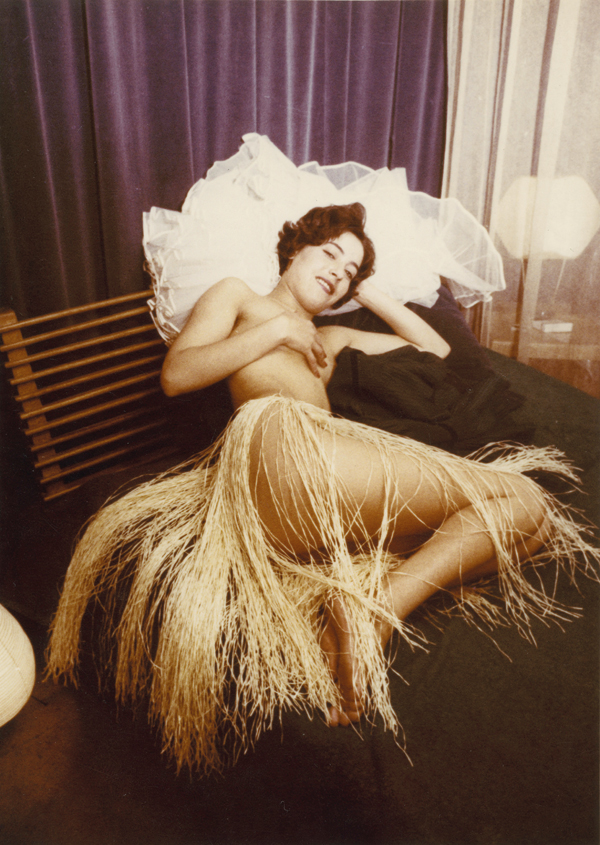Carlo Mollino’s Erotic Polaroids
An exhibition at CAMERA, Turin, illustrates photography's key role for the enigmatic polymath
An exhibition at CAMERA, Turin, illustrates photography's key role for the enigmatic polymath

Since a cache of erotic Polaroids were posthumously discovered in a shoebox in Carlo Mollino’s Turin apartment in 1973, photography has been a key part of the mythology of the protean, enigmatic polymath – another mysterious turn in a career that took in architecture, design, writing and, on one occasion, competing in the Le Mans race. Yet ‘L’occhio magico di Carlo Mollino: Fotografie 1934–1973’ (The Magical Eye of Carlo Mollino: Photographs 1934–1973) – an exhibition of more than 500 items spanning four decades and the most substantial survey of Mollino’s photography to date – reveals that the medium was a consistent pursuit throughout his career, playing a unique role in integrating his otherwise varied interests and activities. Whether flying, racing, skiing or making, Mollino seems to have photographed whatever interest currently possessed him.

The exhibition opens with two images of Mollino’s first architectural commission,from 1934 – one of many examples of him recording and re-interpreting his own work through photography. Most striking among these are the photo collages of his projects, made in collaboration with Riccardo Moncalvo: shots of the Società Ippica Torinese equestrian club (1941), for instance, which Mollino overlaid with close-ups of muscular horses by Hein Gorny, or a 1946 collage that moves his design for a World War II monument in Turin’s Cimitero Monumentale up into the clouds. There are several collages from 1947 featuring the Casa del Sole in Cervinia – a tower block with a dramatically slanting facade – that were published in Domus before the building was even constructed; superimposing views of the tower onto mountains and snowscapes, Mollino creates a dizzying effect, closer to an Egyptian monument than a modernist development.
Another of the small number of photographs Mollino chose to be published during his lifetime is Camera incantata (Enchanted Room, 1938–40), a dreamlike view inside an artist’s studio, featuring a plaster cast of an antique statue, a giant conch shell and a glimpse of Mollino’s own face, reflected in a mirror. The work’s title plays on the fact that ‘camera’ comes from the Latin word for chamber or room; looking at the photographs Mollino shot within the interiors he created, it seems that, for him, spatial design and photographic composition were two parts of the same path towards image-making. As the exhibition catalogue posits, it’s as though Mollino’s houses are ‘made to be photographed’. Certainly, few of his apartments were designed with functional, day-to-day living in mind; rather, they were settings for fleeting gestures or rituals.

The figures who pose within Mollino’s photographs of his rooms are overwhelmingly female and, as in the aforementioned sensational Polaroids, very often nude. The show’s last room, bisected by a red velvet curtain (part of the brilliantly showy, but never tacky exhibition design), is devoted to such images. Surveying this, I experienced a similar feeling to looking at E.J. Bellocq’s photographs from the Storyville red-light district in New Orleans: that of a deep visual sensitivity, even empathy, rubbing up against a system of gender relations that is anything but kind. For Mollino, one suspects, objectification came naturally: compare the painful poses held by the skiers he obsessively photographed in the early 1940s with the folding, angular energy of his famous glass and wood table for Casa Orengo – captured in an intimate 1949 photograph shown here – and see how the body can become a thing. More troublingly, in a 1948 photograph, a woman is shown from behind: naked but for a bodice, she kneels at a typewriter, her buttocks printed with the initials C.M.. The catalogue frames this as a witty reference to Man Ray’s Le Violon d’Ingres (Ingres’s Violin, 1924); it’s hard not to see it equally as a kind of possessive branding of female flesh.
If the show is hugely illuminating of Mollino’s practice, it also reveals something unknowable at its heart: mystery being, of course, part of what makes Mollino such an enthralling figure. The first edition of his treatise on photography, Il messaggio dalla camera oscura (The Message from the Darkroom, 1943), is displayed here: the frontispiece features the head of an ancient sculpture of Tiye, an Egyptian queen from the 13th century BCE, who is never mentioned in the book’s text. Many of Mollino’s female subjects are posed so that their faces are hidden – part of a rich lineage of women turning away which Jennifer Higgie once limned in this magazine. Whatever else the pose renders the subject, Higgie wrote, ‘she is ultimately irreducible’. If Mollino’s gaze is sometimes dehumanizing, its distance perversely grants his subjects – person, table and building alike – an enigmatic dignity.
Main image: Carlo Mollino and Riccardo Moncalvo, Società Ippica Torinese (Torinese Horse Racing Company), photomontage, 1941. Courtesy: The Estate of Carlo Mollino and Camera, Turin

























